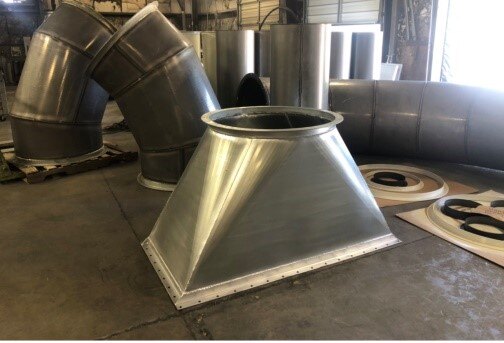When you are dealing with dust collection system, the most important component is having the correct airflow going through your system so that the dust collection is properly done. While this initially appears to be simple it is the most complex part of a dust collection system. To put it simply, every component from the pickup hoods to the exhaust stack affect the airflow going through the system. And any changes, whether deliberate (ex. changing filters) or accidental (filters plugging) the airflow in the system will be affected. The following explains the different components in the dust collection system and how they affect the airflow.
Pickup Points/ Hoods
Most dust collection system have pickup points/hoods that are used to collect the dust by pulling the air around the location into the dust collection system. The amount of air and the profile of the airflow is based on the hood design. Some hoods are located close to the dust source while other hoods are used to pick up dust across a large area. Using the correct hood is very important when you are designing the dust collector. If you are using a hood designed for pinpoint collection but need to collect over a wide area you will not get the dust collection you are looking for. If you use a wide area hood for pinpoint collection you will be collecting more airflow that is required, thereby increasing the size of you dust collection system.
Ductwork
Now that we have captured the dust in our hoods, we must transport the dust from the hoods to the dust collector. Sometimes you located the dust collector right next to the area you are collecting the dust and sometimes it is located all the way on the other side of the facility. Some dust collectors are dedicated to a single area or process while others handle multiple areas (hoods). All of this requires ductwork to transport the air from one place to another.
Click here to get the complete version of the article: Airflow Through a Dust Collection System.
Dust Collectors
There are many different types of dust collectors that you can use in the system. Each of them have certain strengths and weaknesses. The most common are baghouses, cartridge collectors and wet scrubbers.
Baghouses and cartridge collectors use a filter media that builds up dust and prevents the dust from passing. The filters will be periodically cleaned (by shaking or with compressed air). Over time the dust layer will increase, causing the pressure drop across the filters to increase.
There are multiple types of wet scrubbers used for dust collection. The most common are venturi scrubbers and what can be described as cloud chambers. Cloud chambers use high pressure nozzles to create very small particles to make contact with the dust. While venturi scrubbers force the airflow and water through a small diameter section, forcing the water and dust to contact. Afterward both units have mist eliminators and/or packed towers to collect the water droplet.
Auxiliary Equipment and Accessories
The dust collection system might have auxiliary equipment such as pre-filters, HEPA filters, isolation valves, manifolds and control dampers which could affect the airflow in the system. They all could have pressure drops associated with them, which would need to be added to the system total static pressure for the proper airflow to be achieved by the system.
Exhaust Fan
The exhaust fan is usually the motive power behind the dust collection system. And usually the exhaust fan is a centrifugal blower. One of the characteristics of the centrifugal blower is that the airflow produced by the fan is directly tied to the static pressure produced by the fan at a specific speed. Each centrifugal blower has a performance curve which shows what the airflow and static pressure will be.
The main thing to remember is that if for some reason the pressure drop in the system increases, the airflow through the system will decrease according to the fan performance curve. Often times it is a good idea to install a variable frequency drive (VFD) on the fan so that you can adjust the speed of the fan allotting for changes in filter conditions and other process upsets.
So, to summarize, the dust collection system is sized and designed based on the total airflow going through it. Each of the components has an effect on the whole system, which often times are cumulative. Any modification of the system could affect every other piece of equipment, thereby affecting the total effectiveness of the system. As described above, the dust collection at the pickup points are entirely dependent on the airflow going through them. Any upset, modification, maintenance issue, etc. could affect that airflow, thereby causing the dust collector system not to provide the performance it was designed to do. Therefore, constant monitoring of the airflow in the system is the best way to monitor the dust collection system.
To improve efficiency and safety, there is no substitute for an on-site inspection by an experienced expert. Click below to start with a free 20-minute phone consultation by clicking the button.


